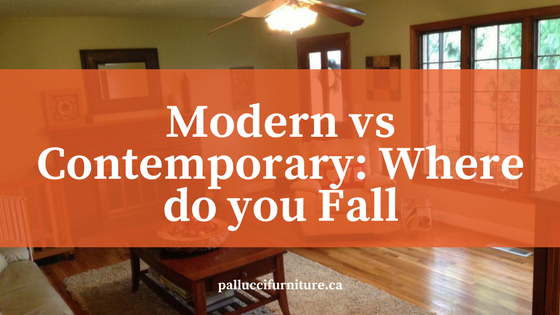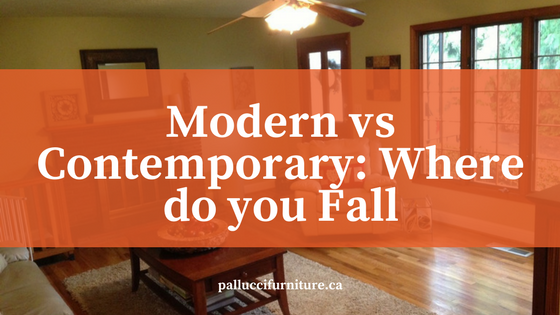
Modern vs Contemporary Furniture
Deciphering home design terminology can be an intimidating task. With the amount of choice consumers have access to these days, there’s a lot to consider and designers, builders, furniture makers, and bloggers all seem to throw around these terms with such reckless abandon that the majority of us give up and just start pointing to the stuff we like.
While there’s nothing wrong with that at all, you could very well be missing out on a more all-encompassing style that suits your tastes perfectly, all because of terminology being lost in translation. As sellers of all types of furniture design, and purveyors of furniture knowledge, we’ve compiled this piece to help you tell the difference between two of the most confused home design terms: modern and contemporary.
What’s the Difference?
The underlying differences of contemporary and modern design may surprise you, because ‘modern’ is not truly modern in regards to time, and ‘contemporary’ isn’t linked to one distinct style in the first place. But, both stick to basic rules that aim to showcase space, rather than stuff. Catch that? Let us explain:
Contemporary
At its core, contemporary architecture and design include the architecture and designs being produced now, in the modern day. If we dive a little deeper, the term contemporary can refer to a specific variety of design in an open-ended manner - meaning that it’s innovative, progressive and forward-thinking, uses the latest in building technologies and design sensibilities.
So in a nutshell, contemporary is rootedin time, even if the designs that come from the modern day don’t resemble the style set by other new designs and pieces.
Modern
Meanwhile, modern design is reminiscent of a specific point in time, and references early and mid 20th century architecture which “embod[ies] the ideals of the machine age: an absence of ornament, structures of steel of concrete, large expanses of glass, a whitewash, and other minimal” expressions including open floor plans, according to Houzz contributor and New York City architect, John Hill.
According to this definition, modern design is actually rather old in scope, getting its inspiration from countering the traditional brick-and-mortar styles associated with the Industrial Revolution from about 1920-1950.
To make things even more interesting, modern design has experienced a resurgence in the showrooms and homes of today. So, because history has a tendency to repeat itself, the minimalist and open concept designs that we’re seeing hold so much influence are in fact a contemporary take on modern design that’s often called retro.
Materials Used
Modern
Modern interior design and furniture choices are easily recognizable by their use of clean, and natural materials. Modern furniture may feature wood, leather, teak, molded plastic and plywood, and even metal accents. Modern furniture is also quite minimal in its appearance, lifted off the ground and not offering much in the way of plush comfort - continuing the openness of modern design’s principles.
Floors are often bare, but the Relish Interiors blog notes that when area rugs are used, they typically follow the use of natural materials, showing up as wool or reed and are usually neutral in colour.
Contemporary
Existing contemporary design is lucky, in that it can evolve and become what it wants to become. For this reason, contemporary design and furniture can be very eclectic and utilize pieces and and styles from different eras - including the modern era. Contemporary design doesn’t have to be designed and built now, it just has to come into existence now.
For example, a contemporary living room space may incorporate an open concept layout and natural elements like wood and stone like cedar, marble and quartz, and may even keep its finishing details reminiscent of modern design choosing to keep lines clean and finishing touches linear. However, a contemporary home can boost the level of comfort, practicality,and colour to offset it from being called a modern space. Contemporary furniture materials can include warm coloured leathers, stained wood and glass, metal, and organic materials like wool, cotton, burlap and even clay.
Identity
Contemporary
Contemporary design these days is all about balancing elementsof comfort and warmth, with a decluttered, clean space. For this reason, contemporary style is also a popular choice for offices and retail spaces, not just homes. This contrast creates a unique identity that can evolve as time passes, so contemporary design and furniture don’t really have to adhere to a rigid definition. One day, what we deem to be a contemporary sofa will change, and a new character will emerge to better support the style.
A big perk to choosing a contemporary style for your home is the chance to include colour.
In this way, developing the identity of your spaces is never limited to a one-time only opportunity - instead, contemporary character allows you to change your mind down the road and develop a sense of style that suits your lifestyle.
Modern
Because modern furniture and architectural design is rooted in a specific category that pertains to a moment in time, its identity is moreconfidently defined. Modern design has less opportunity to adapt and change, because it must adhere to a set of design principles to be considered modern. This means that while the identity of a space that follows a modern design mentality may be fixed, it relieves the customer from having to choose through an almost limitless bounty of furniture choices.
Luckily, modern design principles have been around since the 1920’s, so there’s a clearly defined selection of designs, furniture and houseware to choose from.
Where Do You Fall?
Like most choices we have to make when it comes to our living spaces, it’s all up to you to determine the vibe and energy that’s going to adorn your home base. Individual style always plays a big role, but sometimes a pre-determined style like that of a modern design can make sprucing up and reimagining your home a breeze. Alternatively, if you’re more about warming up your space and adding some eclectic charm here and there - maybe you aren’t into a specific design mentality.
There’s no definitive way to tell which design school you fall into; but you’ve got access to your own heartstrings - as always, we recommend going with your gut and feeling out a few different options before settling on one thing. If you’re a free spirit, you’re likely going to adopt a more contemporary design perspective. If you’re more about clean lines, rigidity, and following a set plan that breaks free of traditional building forms, a modern approach could be perfect for you.
Trust yourself, and always cross compare furniture and architectural design before revamping your home.

